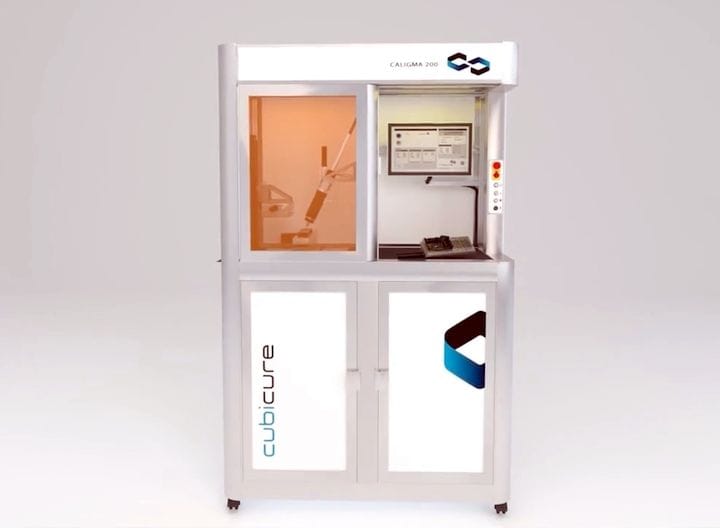![The Caligma 200 3D printer uses a “hot film” process [Source: Cubicure]](https://fabbaloo.com/wp-content/uploads/2020/05/image-asset_img_5eb09dbc6d577.jpg)
I’m looking at an unusual way to perform SLA 3D printing by Cubicure.
Cubicure is a startup company from 2015, when they grew out of research taking place at the Vienna University of Technology regarding the development of unusual polymers for 3D printing. Their original goal was to produce photopolymers having properties similar to conventional non-resin engineering materials.
But since 2017 they’ve also been marketing a 3D printer of their own design that uses some of the principles they’ve learned along their journey, in particular the “hot film” approach.
In a conventional SLA system a laser simply blasts a vat of photopolymer resin, solidifying whatever sections it illuminates. Through the use of a motion system the process repeats layer by layer to form a complete 3D object. However, one of the great tragedies of SLA 3D printing is that the resin must be rather thin to flow around the fresh layer to be ready to become the next layer.
That constraint has often meant that resin objects are not nearly as strong as those made with conventional engineering materials.
However, it seems that Cubicure may have found a way around this dilemma with their hot film approach.
Instead of having a deep vat of resin as is done with most SLA systems, they have a special applicator that precisely places a thin layer of, guess what, hot resin at the top of the build chamber. This resin is in a very thin layer, and since its applied per layer, its temperature can be maintained easily — and at a higher level than the rest of the print.
![Inside the Caligma 200 3D printer [Source: Cubicure]](https://fabbaloo.com/wp-content/uploads/2020/05/image-asset_img_5eb09dbcf225f.jpg)
This means they are able to apply resins with significantly more viscosity than conventional 3D printing resins. In addition, temperatures are often very critical to achieving the highest-quality prints, and the hot film approach allows the greatest level of temperature control we’ve seen in an SLA device.
They’ve packaged up the concept in their line of industrial SLA printers, the Caligma series. It’s available in several different build chamber sizes, based on customer requirements.
They can also build the machine’s laser system to be optimized for different wavelengths, including 405nm and 375nm. This means the Caligma series should be able to handle many different resin types. However, at this time Cubicure seems to offer only three options: a basic material, a high-resolution material, and a high-temperature material. It’s very likely that they will offer more types in the future.
The Caligma machine is definitely not for casual use, as its precision temperature controls are meant for those with serious engineering needs. If your business has those needs, then you should consider Cubicure’s offerings.
Via Cubicure











FELIXprinters has released a new bioprinter, the FELIX BIOprinter, which is quite a change for the long-time 3D printer manufacturer.